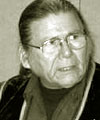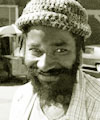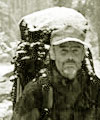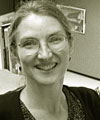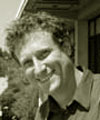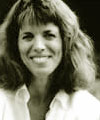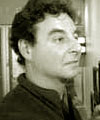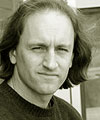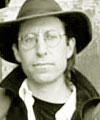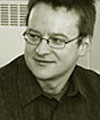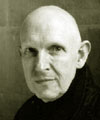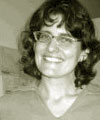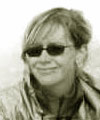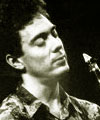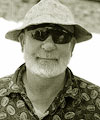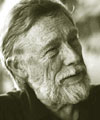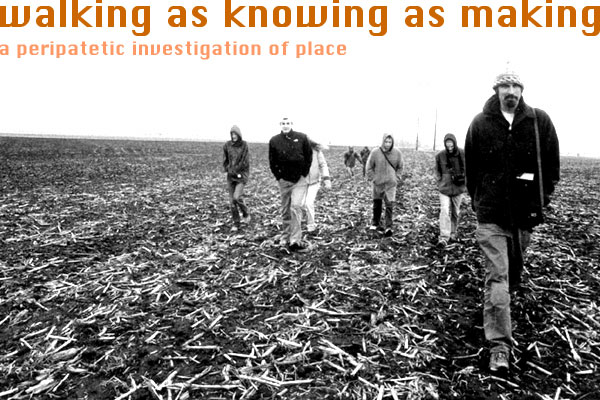 |
... A PROTRACTED SYMPOSIUM ... HOME & INTRODUCTION
// SCHEDULE & PARTICIPANTS // BIBLIOGRAPHY
& LINKS DETAILS // SESSION I / SESSION II / SESSION III / SESSION IV SESSION I > February 24-25, 2005 > DETAILS SESSION II > March 10-11, 2005 > DETAILS SESSION III > April 7-9, 2005 > DETAILS SESSION IV > April 28-30, 2005 > DETAILS SESSION V > TBA
During this time in California, from 1976 to 1983, Banks earned an Associates of Arts degree at Davis University and taught at Deganawida Quetzecoatl (DQ) University (an all Indian-controlled institution), where he became the first American Indian chancellor. He also established the first spiritual run from Davis to Los Angeles, California in 1978 (now an annual event) and organized the Longest Walk from Alcatraz to Washington, D.C. that same year. This 3,600 mile Walk was successful in its purpose: to gather enough support to halt proposed legislation abrogating Indian treaties with the U.S. government. In the Spring of 1979 he taught at Stanford University. Later while living on the Onondaga Nation in upstate New York Banks organized the Great Jim Thorpe Longest Run from New York City to Los Angeles, California. A spiritual run, this event ended in L.A. to begin the Jim Thorpe Memorial Games where the gold medals Thorpe had won at the 1912 Olympics were restored to the Thorpe family. In 1985 Banks left Onondaga to surrender to law enforcement officials in South Dakota and served 18 months in prison. When released, he worked as a drug and alcohol counselor on the Pine Ridge Indian Reservation. Banks received the idea of traditional sacred running in 1978 when he began Sacred Run. Since then it has become a multi-cultural, international event with participants from around the world joining Native American runners to carry the message of the sacredness of all Life and of humankind's relationship to the planet, Mother Earth. Each year, Banks leads Sacred Runs. As of 1996, Banks has led runners over 58,000 miles through the United States, Alaska, Europe, Japan, Canada, Australia and New Zealand. In 1994, Banks led the four month WALK FOR JUSTICE (WFJ) from Alcatraz Island in San Francisco to Washington, D.C.. The purpose was to bring public awareness to current Native issues. Dennis Banks stays involved with American Indian issues, AIM activities, Sacred Run, and travels the globe lecturing, providing drug and alcohol counseling, and sharing his experiences. His autobiography "Sacred Soul" was published in 1988 and won the Non-fiction Book of the Year Award. "Ojibwa Warrior: Dennis Banks and the Rise of the American Indian Movement", written by Banks and Richard Erdoes, was published in 2004 by the University of Oklahoma Press.
"To condense the odyssey of anybody's life into a few paragraphs seems mildly criminal, and in the case of Francis it seems positively felonious. A book would hardly catch the details. (Actually, we'll see about this: Francis has just signed a contract with Chelsea Green to write the story of his adventures.) Anything shorter runs the risk of begging more questions than it answers. Caveats aside, here goes: The year was 1971. Two oil tankers collided in the waters off the Golden Gate, spilling 440,000 gallons of crude, catalyzing one man's troubled mind into a whirl of questions: What is my part in this? Why are we living our lives at 60 miles per hour? How can one person make a difference? Then a friend of his died shortly after the spill. Francis commemorated the man's life with a memorial walk from his home in Inverness to San Anselmo and back. In hindsight you could call it a spiritual crisis, some kind of grief that was pushing Francis to break out of the boundaries of his life." "He decided to see what would happen if he stopped traveling in cars. After a few months of walking, his world view was starting to polarize: the elation he felt at his newfound freedom, the despair he felt watching the world pass him by. He could see that if he continued his decision was going to transform his entire life. And yet, so threatened were people by the statement he was making that he found himself embroiled in many a pointless argument. On his 27th birthday he decided to treat himself to a break from all the noise by spending the day in silence. And in the bizarre, inconceivable way that time accretes, that day turned into two, and those two into a week, a month, a year. Before it ended, Francis' birthday gift turned into 17 years of silence. "You have to experience it," he says, looking back on those years, "You can't explain silence by saying something." But for those of us who are more inclined to view such behavior as an aberration, he will point to its virtues: It quieted his mind, it gave him the opportunity to really listen to others, and it kept his intentions from getting diffused in chatter." "Compelling, and well precedented, is the narrative of the sadhu, the silent, wandering holy man who lives completely on the margins of society. Certainly Francis has been no stranger to the margins. Over the years of his pilgrimage he has spent plenty of time painting in the wilderness or strumming his banjo along the side of some blue highway. But what makes Francis' life so remarkable is the extent to which he continued to work within the mainstream. For in those years of silence he earned a B.A. in Oregon, an M.A. in Montana, and got his Ph.D. from the University of Wisconsin."
Fulton first came to prominence in the late 1960s as one of a number of artists - including Richard Long and Gilbert & George - who were exploring new forms of sculpture and landscape art. A central characteristic of their practice was a direct physical engagement with landscape. Fulton's time as a student at St Martin's College of Art in London (1966-68) and his journeys in South Dakota and Montana in 1969, encouraged him to think that art could be 'how you view life', and not tied necessarily to the production of objects. He began to make short walks, and then to make photographic works about the experience of walking. At this time, and subsequently, his practice was influenced by an unusually broad set of interests including the subject of the environment and the culture of American Indians. In 1973, having walked 1,022 miles in 47 days from Duncansby Head (near John O'Groats) to Lands End, Fulton decided to 'only make art resulting from the experience of individual walks.' Since then the act of walking has remained central to Fulton's practice. He has stated 'If I do not walk, I cannot make a work of art' and has summed up this way of thinking in the simple statement of intent: 'no walk, no work'. Although only Fulton experiences the walk itself, the texts and photographs he presents in exhibitions and books allow us to engage with his experience.
Research/teaching interests: 19th-century British literature and culture, poetry and the novel from the Restoration to the Great War, gender studies, aesthetics, and historiography. Current projects: a book in progress, “Sibling Anxieties: Family Structure and Literary Authority in Nineteenth-Century English Literature”; preliminary work for extended studies of gothicism, realism and scientific discourse, and of George Eliot's novelistic history of England.
SESSION II > March 10-11, 2005 > DETAILS
Boom! Boom! Boom! Sounds of drums echo off the horizon. Crickets strike a fleeting dissonant chord in their delicate overture to the decaying bodies slumbering under the moist earth. Train bells glow red and begin to ring... something shuffles through the tall grass. I lower my antenna and pack my equipment into a muddy satchel. Tick, tick, tick, tick... I am a geographer, aesthetician, and low-intensity insurrectionist. Specializing in urban reconnaissance and aesthetic booby-traps, my work is an expedition into the seething rainforest of everyday space: a decodable, but delicate and frangible constellation of living and breathing processes. Here there be tygers. Excavating the unclean and profane materials of conceived and lived environments - the noises, smells, and refuse - my task is to uncover and disrupt hidden forces, specters, ideologies, and encampments. Research and data gathering enjoy an uncongealed relationship to covert action and cultural monkeywrenching. As a serious social researcher, I am interested in proposing new and unlikely models with which to describe the spaces that we inhabit. As an aesthetic interventionist, my interferences of normative spatial practices create situations conducive to pedagogy, counterproduction, and fleeting subversion.
SESSION III > April 7-9, 2005 > DETAILS
In developing large-scale projects such as a photo agency for inner city youth, cultivating a vertical community garden downtown, or developing various subversive tele-communication systems, Simon has worked with diverse populations of people. As an extension of his art practice, Simon works with artists and non-artists in the making of public works as a way of pushing social awareness of how public space operates and for whom it is designed to do so. By fostering critical thinking in cultural workers, he believes in the social agency of art making. He has co-authored with Vancouver Art Gallery's Public Programs, a Grade 11 and 12 curriculum on contemporary public art and published a catalogue on the public projects of collective echoes. He was recently the artist in residence at International Art Space, Kelleberrin, Australia with Laurie Long where they launched his GPS applications. He is now artist in residence at the Surrey Art Gallery TechLab expanding his explorations in the use of GPS technology, and relational aesthetics with C.H.A.R.T. Laurie Long, an independent filmmaker, has spent the past decade working in a broad variety of roles in productions ranging from guerilla style performance poetry videos and independent documentaries, to extreme sports television. Her work has been broadcast extensively in Canada, screened theatrically and exhibited internationally. Most recently working as artist in residence at International Art Space Kellerberrin Australia, Laurie collaborated with artist M. Simon Levin on Centre For S.A.L.T Expression - a site-specific multimedia production exploring relational aesthetics in a remote Australian farming community stricken with land salinity. Her ability to make people comfortable in front of her camera has gained her remarkable access into the lives of her many documentary subjects. From exploring SM dungeons and fetish parties, to train hopping with a paraplegic graffiti artist, Laurie explores the lives of characters engaged in exceptional circumstances. In her commitment to exploring diverse voices in marginalized cultures, she works toward changing the demographic landscape of representation in the mainstream media.
For Macauley, walking is more than a way to get from place to place. Macauley, Assistant Professor of Philosophy and Environmental Studies at Penn State-Delaware County, has focused much of his work on how our movement over, about, around, and even within the earth affects the study of environmental practice. Blending his love of philosophy with a growing interest in environmental issues eventually led Macauley to consider the relationship between walking and environmentalism. Concerned that environmental philosophy too often focused on matters related to place and displacement in its treatment of plants, animals, and land at the expense of the motion of people through these regions, Macauley poured over philosophical writings to better understand the meaning of motion. "Walking is an activity that can reconnect us with nature and with ourselves," Macauley says. "We can use walking as a way to reanimate our senses and to see the natural world. Philosophical naturalists like Thoreau recognized this--as did Taoist and Zen Buddhist monks--and understood the elemental relationship of our bodies to the earth. Being aware of this relationship can help us as we look for solutions to current environmental crises." Essays include: "The Art of Ambling: Environmental Aesthetics on the Move", "Walking as Environmental Practice", "Walking the City: An Essay on Peripatetic Practices and Politics", and "Walking and Environmental Aesthetics". Book in progress: "Walking the Earth: Philosophical Foot Notes" (Bloomington, IN: Univ. of Indiana Press, forthcoming 2005).
ANDREA PHILLIPS (PhD) is a writer and art historian, and currently Assistant Director of MA Curating at Goldsmiths College, University of London. Paper > Walking into Trouble: Ethics and Aesthetics in the Contemporary Pedestrian Abstract > Walking seems to promise something to the contemporary artist and architect: a technique of overcoming the problems of representation that have amassed in art practice and criticism at the end of modernity, in which the politics of identity formation and, especially, location have filtered away any resplendent space for art, any place where art might simply sit. The promise of walking is that it might provide an alternative technology for art and architecture, in which space, seemingly social, gets moved through rather than settled upon. Immediate migrancy, avoidance of occupancy - these are attractive states within a contemporary political countenance as they seem to offer an obverse to more phenomenologically inspired modes of object contemplation. But can walking-as-art hold to this promise, particularly as it is acted out across a contemporary landscape? This paper could examine the work of a number of artists and architectural practices, including Guy Debord, Richard Long, Archigram, Bruce Nauman, Constant, Bas Jan Ader, Krzysztof Wodiczko, Rachel Whiteread, Francis Alÿs, Muf, Kate Davis, Tacita Dean and Tim Brennan, to test out the politics of some walking assumptions. The result would hope to prove that walking is one marker of an economy in which the desire for process-based, participatory, embedded experience has replaced ideals of abstracted contemplation for reasons that might seem ethical but are in actual fact always already aestheticised. The paper would contrast the way in which various social theorists and philosophers approach the idea of urban space and encounters between people (citizens, artists, architects) within it. At the heart of the idea is a critique of Michel de Certeau's blinded and autistic walker, whose celebrated creativity is only available through a lack of political agency. This is compared with Gilles Deleuze and Felix Guattari's equally ambivalent concept of nomadology, in which the moving figure is willed to become a productive but non-assimilable force, riding through a rejected political landscape, outside the bounds of citizenly recuperation.
CHRIS TAYLOR - LAND ARTS OF THE AMERICAN WEST is a studio-based, field study program that investigates land arts from pre-contact Native American to contemporary Euro-American cultures. It is a program that views place as a continuum across time and cultures, a program that demonstrates the potential of situating questions between disciplines and definitions, between the land, art, and design. Land arts practices can include everything from constructing a road, to taking a walk, building a monument, or leaving a mark in the sand. We learn from the fact that Donald Judd surrounded himself with both contemporary sculpture and Navajo rugs; that Chaco Canyon and Roden Crater function as celestial instruments; and that the Very Large Array is a scientific research center with a powerful aesthetic presence on the land. Land Arts is a collaboration between Studio Art at the University of New Mexico and Design at the University of Texas at Austin. The program is co-directed by Bill Gilbert (UNM) and Chris Taylor (UT). Fourteen students and two faculty, spend a semester living and working in the southwestern landscape with guest scholars in disciplines including archeology, art history, architecture, ceramics, criticism, writing, design, and studio art. Occupying the land for weeks at a time, living as a nomadic group and working directly in the environment, students navigate issues of culture, site, community and self. They develop skills of perception and analysis unattainable in a standard classroom setting. LAND ARTS is an interdisciplinary model of education that hinges on the relation between place and human interventions in the land. The desert provides an amazing laboratory to read the lines of force that exist in the world. It is a pedagogic landscape that exposes itself in ways that are both unforgiving and highly focused. Creating a situation where students are exposed to and engaged by the realities of the land; the marks left by past inhabitants—water, wind, animal, human, industry, carelessness, willful conquest, and hopeful coexistence. We strive not to differentiate the value of traces left by humans, animals, or environmental factors. Instead we ask what can be learned from reading those traces, those marks, and what is the particular nature of that reading. Unlike a model that seeks to explain or deduce a truth from a set of conditions, here we are seeking to re-invigorate invention (not in terms of opposition, but in terms of connection). The goal here is one of opening out and connecting work to conditions beyond oneself. LAND ARTS transposes the studio and classroom into the environment. Set apart from the Grand Tour, a tradition of collecting and consuming, LAND ARTS is about making. As artists and designers, we move away from issues of interpretation towards the possibilities of what we can make. LAND ARTS hopes to confirm the idea that if you bring students out into the world instead of the world into the classroom, you can fundamentally change how we learn, create, and view our surroundings. In this context we strive to make deeper and more precise connections within our work and be inspired to create work that makes broader connections outside of ourselves. Chris Taylor studied Architecture at the University of Florida and at Harvard’s Graduate School of Design receiving his Master of Architecture in 1990. Since then he has lived throughout the southwest (New Mexico, Texas, and Arizona) and has taught Architecture at the University of Florida in Gainesville, North Dakota State University in Fargo, and at the University of Arizona in Tucson. In 1998 he was awarded the Steedman Traveling Fellowship in Architecture as a result of the international biennial architecture competition hosted by Washington University in Saint Louis. In Fall 2001 he joined the Faculty of Design at the University of Texas at Austin to contribute to the ongoing development of a making-based design program. His design practice, the ARCHITECTURE WORKERS COMBINE, has built work in New Mexico, Arizona, and Texas and continues to be invested in the mechanics of building ideas.
SESSION IV > April 28-30, 2005 > DETAILS
Dr. Abram is also an accomplished sleight-of-hand magician who has lived and traded magic with indigenous magic practitioners on several continents. He began practicing sleight-of-hand magic in his late teens, and it is this craft that sparked his ongoing fascination with perception. When he was nineteen, Abram began working regularly as "house magician" at Alice's Restaurant in Massachusetts, and soon was performing steadily in clubs throughout New England. He took a year off from his studies at Wesleyan University to journey as a street magician through Europe; upon graduating summa cum laude from Wesleyan in 1980, Abram began traveling as an itinerant magician throughout rural parts of Southeast Asia, living and studying with traditional magicians and medicine-persons in Sri Lanka, Indonesia and Nepal. Abram became increasingly fascinated by the interactive relation between these traditional magicians and the various animals, plants, and natural elements that constitute the local terrain. Upon returning to North America, he became a careful student of natural history and ecology while continuing to perform throughout Canada and the United States. A much-reprinted essay originally published in The Ecologist (written while he was studying at the Yale School of Forestry in 1984), entitled "The Perceptual Implications of Gaia," brought Abram into alliance with the scientists formulating the Gaia Hypothesis, and he was soon lecturing in association with biologist Lynn Margulis and geochemist James Lovelock in both Britain and the United States. In 1993, Abram received his doctorate from SUNY at Stony Brook for his work on the ecological dimensions of perception and of language. At the heart of Abram's ongoing research is an examination of the ecology of perception (the manner in which sensory perception bind the human organism into the more-than-human natural world). More recently, his work also analyzes the decisive influence of language upon our perception of the earthly environment, and argues that human language is much more intimately related to the more-than-human natural landscape than has been conventionally assumed. Dr. Abram's papers and essays, in such journals as Environmental Ethics, Orion, The Ecologist, Parabola, and Wild Earth, have been widely reprinted and anthologized in numerous books. His first book, The Spell of the Sensuous, termed "revolutionary" by the Los Angeles Times and the Village Voice, has been described in Science as "a truly original work: Abram puts forth his daring hypothesis with a poetic vigor and argumentative insight that stimulate reconsideration of the technological commonplace . . . With Abram anthropology becomes a bridge between science and its others." (Science, January 10, 1997). Frequently called upon as a spokesperson for wild nature, Dr. Abram has been the recipient of fellowships from the Watson and the Rockefeller foundations. Dr. Abram and his wife, Grietje Laga, are the founders of Alliance for Wild Ethics (AWE), an organization dedicated to ecological education and the rewilding of community and culture.
Tim’s research interests are in social and cultural geography. Specifically he is writing a book on geographies of mobility ranging from ballroom dance to the international airport. His interests centre on the role of geographic thought (about such things as mobility, place, landscape, space etc) in the constitution of social and cultural life. He is keen to show how geographical imaginations and practices play powerful roles in the production of relations of power, domination and resistance. Cresswell is the author of "The Tramp in America"; "In Place / Out of Place: Geography, Ideology, and Transgression"; and "Mobilizing Place, Placing Mobility: The Politics of Representation in a Globalized World".
As a director of, and performer with, a series of companies - Transitions Community Arts Project (1971-1972), RAT Theatre (1972-1973), Cardiff Laboratory Theatre (1973-1981), Brith Gof (1981-1997) and Pearson/Brookes (1998 - present) - I have developed and pioneered innovative approaches in the practice, theory, pedagogy and documentation of performance, recognized both by continuous support from the Welsh Arts Council and by international and academic attention. To the spectrum of Welsh theatre, my work with these companies introduced: physical theatre, devised performance, workshop practice, site-specific performance, international co-production, international seminars, foreign touring, performance with the physically disabled I have created over 100 productions, which have been presented at major festivals in Europe and South-America, and I have undertaken collaborative projects with companies in locations from Poland to Hong Kong. I have organized training schemes and seminars in many of the major academic drama departments in Britain and I have run workshops for students from Venezuela to Norway. I was tutor in Drama at Llanover Hall Youth Arts Centre (1972-76) and guest tutor on the MA Course in Theatre Studies, University, College Cardiff (1975-77). Since October 1997 I have taught in the Department of Theatre, Film and Television in UW Aberystwyth where I have been undertaken academic teaching, practical classes and the direction of productions, in both English and Welsh, with all three years of the undergraduate programme in Drama and with students on the taught MA schemes ‘Theatre and the World’ and ‘Theatre, Film and Television’. I have supervised PhD theses both internally and externally. In 1999 I introduced one of the first undergraduate degree schemes in Performance Studies in Britain and designed and managed the creation of nine course modules that constitute the scheme. I have published and spoken widely on contemporary performance theory and practice. My most recent published work Theatre/Archaeology (Routledge 2001), co-authored with Michael Shanks, Professor of Classics at Stanford University, constitutes part of an ongoing examination of points of convergence between contemporary performance theory and interpretative approaches in archaeology: an interdisciplinary approach to recording, writing, illustrating and animating the material past. In April 2002 I was Distinguished Visiting Scholar at Rutgers, State University of New Jersey and in July 2002 Visiting Lecturer at the Johannes Goethe University of Frankfurt.
WALKING 9-5 > I will be making a walking project in Vienna called Walking 9-5. I will start each day in the center of the city, and walk for 8 hours in as straight a line as possible from the center out. I will do this for 15 days, each day heading in a different direction. I have made this project in NYC and Amsterdam. In NYC, I only reached each edge of the city in 8 hours. In Amsterdam, I was in the countryside in 2 hours, through another city in 5 hours, and to the ocean in 8 hours. Another day, I walked from Amsterdam to Utrecht in 8 hours. It changes the conception of the size of the city when you know how far you can walk in 8 hours. This project is an attempt to translate time directly into space. In the US, many people work 8 hours a day, either in a factory or at a desk in front of a computer. I wanted to see how far one could propell oneself in the most ancient, unaided way, walking, in that same amount of time. The drawing will also reflect how much money I spend during this project.
She is author of The Pursuit of Pleasure, (London: Athlone Press, 2002). She is also editor of A Place Between, Public Art Journal, issue 2, (October 1999) and co-editor of Strangely Familiar: Narratives of Architecture and the City, (London: Routledge, 1995), Gender Space Architecture: An Interdisciplinary Introduction, (London: Routledge, 1999), Intersections: Architectural Histories and Critical Theories, (London: Routledge, 2000) and The Unknown City: Contesting Architecture and Social Space, (Cambridge Mass.: MIT Press, 2000). She is currently completing A Place Between: Art, Architecture and Critical Theory, for Reaktion Press and working on a project of site specific writings entitled 'Writing Aloud'. She considers her writing to be a form of architecture, a critical spatial practice, and is exploring through research and teaching the possibilities for site specific writing. Recent work includes essays for artists and architects, such as Sharon Kivland, Jane Prophet and Hawkins/Brown and galleries, such as The Wapping Project and BALTIC, as well as text-based pieces for Brandon Labelle, Simon Morris and Brigid McLeer.
Rothenberg is also a composer and jazz clarinetist, and he has five
CDs out. His second record, On the Cliffs of the Heart, with percussionist
Glen Velez and banjo player Graeme Boone, was released by New Tone Records
in the autumn of 1995. John Cage praised their "sense of virtuosity
traveling all over the world." Jazziz named it one of the top ten
releases of 1995. In 1999 he released Bangalore Wild, a collaboration
with the Karnataka College Rothenberg is professor of philosophy and music at the New Jersey Institute of Technology.
HOME & INTRODUCTION // SCHEDULE & PARTICIPANTS // BIBLIOGRAPHY & LINKS ... A PROTRACTED SYMPOSIUM ... |
 |
